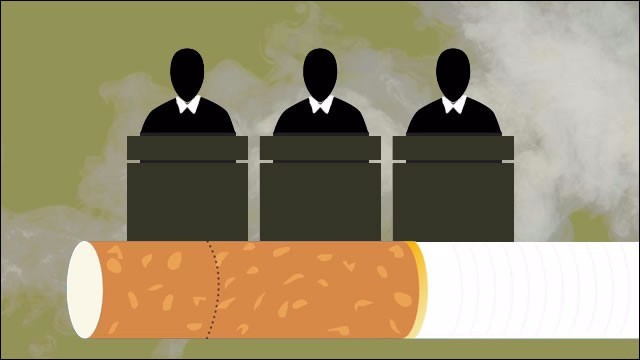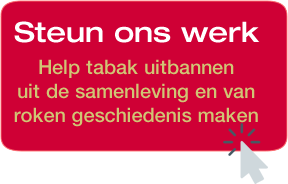European case on the ‘rigged’ cigarette and unlawful measurements
Unlawful filter cigarettes with ventilation holes must be prohibited
1 maart 2021

The so-called ‘rigged cigarette’ is far more harmful and addictive than legally allowed and should therefore be removed from stores. After all, public health must be the legislator's primary concern in this context.
Cigarettes are more harmful and addictive than the tobacco industry suggests, as smokers ingest much more poison and nicotine than official measurements indicate. Cigarette filters have tiny holes through which air is drawn in during official measurements, which dilutes the toxins. However, smokers cover those holes with their mouth and fingers, so that the dilution is not necessary in practice.
In the investigation for preceding the complaint in 2016 against the tobacco industry, the Youth Smoking Prevention Foundation (SRPJ) discovered that the tobacco industry had not only invented the holes in the filters (the ‘rigged cigarette’) to influence the measurement of the toxic emissions of cigarettes. The legally prescribed measuring method also appears to come from the sleeve of the tobacco industry itself.
SRPJ argues that under national and European law the cigarettes currently on the market are contrary to government obligations to protect public health. The foundation therefore took legal action in 2019 together with the municipality of Amsterdam and a number of health organizations. The plaintiffs are seeking a ban on the sale of ‘rigged’ cigarettes.
Ruling by Administrative Court
The Administrative Court in Rotterdam on 7 February 2020 reached a verdict on the question of ‘rigged’ cigarettes. The court expressed serious doubts about whether the current legal method for measuring cigarette emissions (the so-called ISO method), leads to results that are in accordance with other legal regulations.
At issue here are the maximum levels of poisonous substances that smokers may inhale and the European Convention on Human Rights. The court has ruled that the obligation of the EU and the Dutch state to protect public health has been seriously undermined. Consequently, the court has requested a ruling from the European Court of Justice.
‘Rigged’ cigarettes
European tobacco legislation has determined that a cigarette may emit a maximum of 10 milligrams of tar, 1 milligram of nicotine and 10 milligrams of carbon monoxide. The legislation also specifies that cigarette emissions must be measured using the ISO method. Both the SRPJ and the government agency charged with measuring cigarette emissions are highly critical of the method. This is because clean air is drawn in through small holes specifically made in cigarette filters for that purpose by the tobacco industry. According to the Netherlands National Institute for Public Health (RIVM), smokers actually inhale two to three times as much tar, nicotine and carbon monoxide as legally allowed. That is because smokers block these holes with their lips and fingers while smoking.
There is another measurement method that imitates smoking behaviour much more accurately. Called the ‘Canadian Intense’ (CI) method, much like the later developed WHO TobLabNet COP 01 method, it involves blocking the holes, thereby creating similar conditions as during ‘normal’ smoking. The CI method also simulates a more realistic ‘smoke behaviour’ (such as frequency of inhaling). The RIVM takes the view that the CI and WHO measurement methods approximate the reality of smoking much more closely than the ISO method does, even though the latter is prescribed by law and propagated by the tobacco industry.
Background to the legal challenge
SRPJ called on the Netherlands Food and Consumer Product Safety Authority (NVWA) to enforce the legal maxima by employing the more accurate Canadian Intense method. The NVWA dismissed that request “because the law simply prescribes the ISO method”.
On appeal, the Administrative Court in Rotterdam has sided with SJPR and the other plaintiffs, who argue that the legal measurement method conflicts with the government’s obligation to protect the health of citizens, especially children, and that the Canadian Intense method should be used.
European law
Because a Dutch court cannot change European law on its own, the court in Rotterdam has agreed with SRPJ’s request to seek a ruling from the highest court in the European Union, the Court of Justice in Luxembourg. This court does have the power to overturn European legislation and can also instruct the European Commission to solve the problem through legislation. The Dutch Administrative Court has also asked the Court of Justice whether the Netherlands can decide to replace the measurement method with a better one unilaterally, until the issue has been settled at EU level. If the Court of Justice in Luxembourg agrees, this ruling could even mean that the NVWA can impose an immediate ban on the sale of filter cigarettes currently on the market.
The European Court of Justice has asked all parties involved (apart from SRPJ and the tobacco industry, all Member-states, the European Commission and the European Parliament) to give their opinions. Considering all arguments put forward, the Court will give its verdict.
On 22 February 2022, the Court of Justice of the EU issued a ruling, concluding that the Rotterdam District Court can decide for itself whether the measurement method used so far has been in order or whether a method should be used that better approaches the actual smoking behaviour of the smoker. So, the case continues before the administrative court in Rotterdam.
Documents
Verdict by District Court of Rotterdam (20 March 2020)
Memorial by SRPJ (5 October 2020)
Court of Justice of the EU verdict (22 february 2022)
ISO method | measurement | tobacco emissions | EU Court of Justice | legal case | rigged cigarette | Canadian Intense | tobacco






 Rookpreventie Jeugd is geregistreerd als Algemeen Nut Beogende Instelling.
Rookpreventie Jeugd is geregistreerd als Algemeen Nut Beogende Instelling.